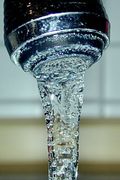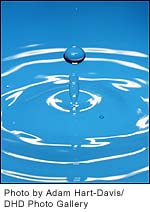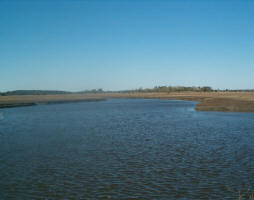 Biblical Waters: Can the Jordan River Be Saved?
Biblical Waters: Can the Jordan River Be Saved?
If Jesus were to plunge into the Jordan River today, he might well injure himself.
The great biblical waterway is now little more than a shallow, unimposing trickle of sludge, a murky body of water that is in danger of withering into nothingness.
"Is that it? Seriously, that's the Jordan? I could jump it," declared one mightily unimpressed American teenager, as we crossed the river from the Kingdom of Jordan to the Palestinian West Bank one blindingly bright afternoon back in October.
There's no real mystery as to how the river famous as the reputed site of Jesus' baptism has sunk so low.
"Everybody's been taking water from the Upper Jordan because everybody needs it," said Clive Lipchin, director of the Center for Transboundary Water Management at Israel's Arava Institute, and one of a number of water experts alarmed by the decline of a river that was never particularly substantial in the first place.
What remains of the Jordan springs from its source high in the Lebanese mountains, before it passes near the Syrian border and along the Jordanian, Israeli, and Palestinian frontiers.
It's one of the most complicated and conflict-ridden regions on Earth, and that goes some way toward explaining the Jordan River's current predicament.
Fighting Over Water
Cooperation between Israel and its Arab neighbors is rare, which leaves the river and its problems hostage to 65 years of distrustful and often hostile coexistence.
"There's no water because Israel steals it all," said Mohammed, a Bedouin goat herder who tends his brother's flock in the parched Jordanian hills near Mount Nebo, where Moses is said to be buried.
"Jordan and the Palestinians are responsible because they waste everything," Yitzhak Adami, a Jerusalem taxi driver, told me, as we wove our way toward a hilltop Jewish settlement in the occupied West Bank.
But as fraught as relations between Israel and Jordan remain, despite the peace treaty they signed in 1994, it's Syria's struggles that preoccupy water policymakers' thoughts.
Indeed, the river might be described as the latest victim in a brutal Syrian civil war that is thought to have killed at least 130,000 people and displaced almost seven million so far. (Read "Damascus: Will the Walls Fall?" in National Geographic magazine.)
Almost 2.5 million refugees have fled Syria to date (up from 550,000 in January last year), and 600,000 of them have settled in arid and water-impoverished Jordan, a country of slightly fewer than 6.5 million citizens. (Read "Journey Without End" in National Geographic magazine.)
Environmental issues have understandably been a very distant second to humanitarian concerns, but the ongoing chaos and fast-increasing mass of refugees needing water have stretched the Jordan River's already desperately meager flow to a trickle.
Refugees Straining Capacity
Some communities in the dusty, pancake-flat expanse of northern Jordan will tell you their cities' water resources long ago reached a desperate state. The new pressures could bring them to the breaking point.
An old farmer sleepily perched next to his fruit stand outside Mafraq sadly shook his head and just repeated "too many people, too many people," when asked about the influx of new arrivals.
At less than 10 miles (16 kilometers) from the Syrian frontier, and 20 miles (32 kilometers) from Deraa, where the opening salvo of the Syrian revolution was fired in March 2011, Mafraq was always going to be the first port of call for many refugees.
But no one could have guessed the enormity of the Syrian exodus.
Syrians now far outnumber longtime residents, and non-Syrian Arabic accents are a comparative rarity in the teeming coffeehouses around Mafraq's potholed main drags.
Over 80 percent of Syrians who are registered with the UN's refugee agency in Jordan arrived in 2013, and a third of them are in Mafraq Governorate.
Many of the established inhabitants of Jordan are originally refugees themselves.
Several waves of Palestinians arrived after the creation of Israel in 1948, and thousands of Iraqis settled there after the Gulf War in the early '90s and during the civil war that rocked their country a few years after the American invasion in 2003.
Read more at the link below.
| Contact information |
Peter Schwartzstein in the Middle East National Geographic
|
|---|---|
| News type | Inbrief |
| File link |
http://news.nationalgeographic.com/news/2014/02/140222-jordan-river-syrian-refugees-water-environment/ |
| Source of information | Peter Schwartzstein in the Middle East National Geographic |
| Subject(s) | FINANCE-ECONOMY , HYDRAULICS - HYDROLOGY , METHTODOLOGY - STATISTICS - DECISION AID , NATURAL MEDIUM , POLICY-WATER POLICY AND WATER MANAGEMENT , PREVENTION AND NUISANCES POLLUTION , RISKS AND CLIMATOLOGY , TOURISM - SPORT - HOBBIES , WATER DEMAND |
| Geographical coverage | Jordan,Israel, Palestine, Syria |
| News date | 24/02/2014 |
| Working language(s) | ENGLISH |
 you are not logged in
you are not logged in





